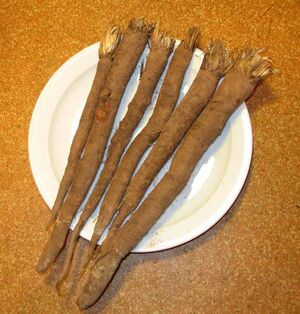Salsify

Black salsify The black salsify is considered nutritious: it contains proteins, fats, the glycosides asparagine, choline and laevulin, as well as minerals such as potassium, calcium, phosphorus, iron, sodium, and vitamins A, B1, vitamin E and vitamin C. Since it also contains the glycoside inulin, which consists of fructose, it is particularly suitable for diabetics.
The thick black skin of the salsify root is inedible and must be removed either prior to or after boiling. If the skin is removed prior to boiling, the peeled root should be immediately immersed in water mixed with vinegar and flour, in order to prevent discolouring. Since the root sap is extremely sticky, it is often more convenient to peel it after boiling the root for 20 to 25 minutes.
Black salsify is often eaten together with other vegetables, such as peas and carrots. But it is also popular in a white sauce, such as bechamel sauce or mustard sauce. Boiled salsify roots may also be coated with batter and deep fried.
Purple salsify The root, and sometimes the young shoots, of Purple Salsify are used as a vegetable, and historically the plant was cultivated for that purpose; it is mentioned by classical authors such as Pliny the Elder. Cultivation in Europe began in the 16th century in France and Italy. In Great Britain it was initially grown for its flower and later became a mildly popular vegetable in the 18th century but then declined in popularity. It is not a popular or very well known food item in the United States. Presently the root is cultivated and eaten most frequently in France, Italy and Russia. However in modern times it has tended to be replaced by Spanish Salsify or Black Salsify as a cultivated crop.
Find recipes that contain 'Salsify'
#salsify #boiling #vinegar #peas #flour #deepfried #phosphorus #bechamelsauce #mustard #proteins #fructose